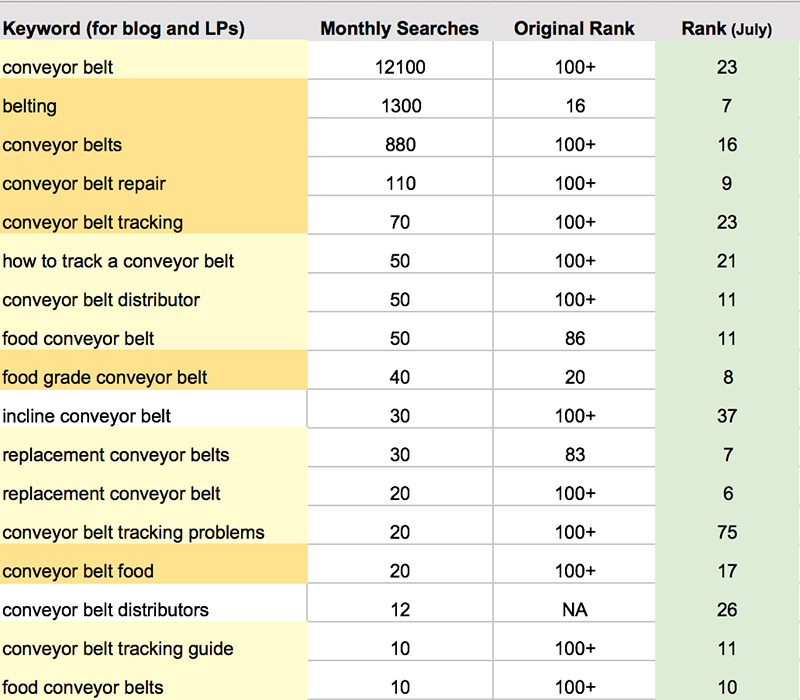
I still remember the moment back in 1997 when one of our web developers called out “Hey guys, there’s a new search engine. It’s called Google.” I opened a browser and typed in google.com. All I saw was a logo and a search box. Unimpressed, I went back to what I was working on. Now, all these years later, Google owns over 90% of search traffic.
Today, search marketing (also referred to as SEO and SEM) plays a critical role in helping you to generate more awareness and leads for your products and services. (For a snapshot of the lead generation process, you can download our Website Lead Generation Checklist.)
Unfortunately many companies are approaching search marketing the wrong way, which is resulting in:
- Loss of business to competitors
- Over-paying for ads
- Low search engine rankings
- Low website traffic
- Lack of website leads
In this article, I’ll cover best-practices for a search marketing strategy that will deliver results.
Search Marketing Defined
Search marketing is the process of gaining website traffic, awareness, and leads from search engines through both paid and unpaid efforts. Successful search marketing efforts put you in front of potential customers who are doing their research online, and searching for solutions, services and products that you can help them with.
The term “search marketing” is an umbrella term that includes both search engine marketing (SEM) and search engine optimization (SEO). SEO is the process of increasing website traffic organically, meaning you do not pay for visitors. SEM is the process of increasing your site’s visibility in search engine results pages through optimization and advertising. In a solid search marketing plan, SEO is one component of SEM.
Search Marketing Best Practices
Search marketing is one of the most important digital marketing tactics you can do to generate web traffic and leads. It compliments SEO and if done properly, it gets your brand/business at the top of the search engines.
In an nutshell, SEM best practices include keyword research and analysis, SEO, paid advertising, and organic referrals from search engines such as Google, Bing and Yahoo.
Step 1: Start with your personas
Most businesses have a good idea of who their target audience is and what their needs are, but in today’s hyper-competitive world, companies need deeper insights into how their customers and prospects think in order to give them a competitive edge.
This is where personas come in. Personas are a detailed snapshot of your ideal customer which includes:
- Demographics
- Their goals and biggest challenges
- Where they go for information
- What technology and devices they use
- What key phrases they use in the search engines
A well-thought-out and researched persona will help you craft consistent and compelling marketing messages that will resonate with your target prospects. Learn more about using personas and positioning to increase awareness and leads.
Step 2: Compile a target keyword list
Developing a solid list of keywords is one of the most important steps in search marketing efforts. You need to know what terms people are searching to find products and services like yours. If you don’t make it easy for them to find you they’ll click on a competitor’s page. Knowing what the right key phrases are, and implementing them properly will help your site rank above your competitors on Google.
Because keywords are the foundational for all your other search marketing efforts, it’s well worth the time and investment to work with a professional to ensure your selected keywords and key phrases are highly relevant to your target audience and effectively implemented for results. Simply put, better keyword research gets you better results.
Step 3: Optimize your site
Once you have a solid list of key words and phrases you’ll need to implement them into your website.
- On-page SEO: Optimize the content that’s on your website to help boost your site’s rankings for specific keywords.
- Off-page SEO: This focuses on the links that are directed back to your website from anywhere else on the internet. The number of backlinks and the websites that have published those links help you build trust in the eyes of a search engine, thus causing your website to rank higher.
- Technical SEO: This type of SEO focuses on your website’s architecture, looking at the backend of the site to see how each page is set up technically. Google cares as much about your website’s code as it does the content.
Step 4: Create and Optimize Content
When it comes to ranking higher on Google search engines, there are a few different ways to get there, but creating fresh and relevant content that is properly optimized is one of the main components.
- Create Landing Pages: A landing page can be the page you’re taken to when you click on an ad, or the page that follows a call-to-action button. Sometimes a landing page can also serve as the homepage of your website. What sets the landing page apart from all the other pages is it’s objective — to convert visitors into leads.
- Write Blog Articles: Blogging helps boost your search engine rankings by positioning your website as a relevant answer to your customers’ questions. Articles and blog posts that specifically use target keywords and a variety of on-page SEO tactics can give you more opportunities to rank higher in search engines, ultimately bringing more customers to your website.
- Optimize Content – This is done on the front end (within your content) and on the back end through your meta descriptions and alt tags.

This excerpt from a target keyword list shows the search volume, original ranking and current ranking for each keyword. Landing pages and blog articles that are optimized for a keyword phrase help increase search rankings—which in turn increase search traffic and leads.
Step 5: Optimize for Local Search
Mobile searches for ‘where to buy’ have grown 85% since 2015, especially when searching for businesses that have a physical location. Start here:
- Google My Business – 8 out of 10 people find the location of a business by using Google Maps. Claim your local listing on Google so you can take advantage of all the people who are looking for your company.
- Reviews – Asking for a genuine review on Google can help boost your rankings.
- Social Media – Post and like other relevant content on social sites. Create dynamic content, related to your business, that will help solve your reader’s problems. This creates customer loyalty and helps turn casual browsers into loyal customers.
Step 6: Optimize for YouTube
YouTube has been referred to as the world’s second largest search engine, but it can also be used to benefit your website’s search marketing efforts:
- YouTube Analytics can help you build personas
- Increase search visibility through Google video results
- YouTube provides keyword data through their analytics, compare these terms to your previously completed keyword list and note the similarities and differences
- You can run retargeting ads through YouTube
Step 7: Paid Search Marketing
When you think about implementing paid search marketing, you should always use it as a complement to your inbound marketing efforts. SEO and SEM work hand-in-hand and you will always yield higher results when you use the two together.
Benefits of paid search:
- Targeted – You choose what keywords and phrases you want your ad to show up for, and you set the budget for how much you are willing to pay for each click. You can also target specific locations and exclude certain keywords.
- Cost Effective – You can budget the exact amount you want to spend and you can measure where that money goes. You can also track how many leads you’ve generated from each paid search.
Types of paid search marketing:
- Pay Per Click (PPC) – Since you only pay when a user reaches your website, this can be a very efficient way of advertising. But, you need to invest in the time to make the campaign work for you. As of 2019, on average, businesses make $2 in income for every $1 they spend in AdWords.
- Google Shopping Ads – Google shopping ads appear at the top of the search results and most often, people who search for products on Google have already done some research and are closer to making a purchasing decision.
- Social Media Ads – Social media has made it incredibly simple to reach the right target audience, and just like the other forms of paid advertising you can set your budget and see precise results.
- Remarketing/Retargeting – By targeting people who have already visited your website, you can increase brand recall and studies show that remarketing campaigns have higher conversion rates. Our clients have had excellent results with this tactic, because the prospect is already familiar with them, and the ad costs are much less than traditional pay-per-click ads.

Retargeting ads display products you previously viewed on other websites. They can be effective and are less expensive that traditional Google Ads.
Paid Search Caveat: When you setup a paid search campaign, bounce rates tend to be higher than organic traffic, and mobile users can really chew up your budget quickly. We recommend setting up separate mobile campaigns in order to preserve your budget for higher-converting desktop users.
Other Best Practices
- Optimize your images’ alt text – Because search engines can’t see images the same way humans can, an image’s alt text tells them what an image is about, which ultimately helps those images rank higher in search results.
- Optimize your URL – Include a keyword search term in your page URL because this is one of the first things search engines look at and index when they crawl your site.
- Make sure your site is mobile friendly – Because so many users are searching from a mobile device, Google displays the mobile-friendly versions first.
- Meta descriptions – should be compelling, relevant, and include the keywords for which you are trying to rank.
- Link internally whenever possible – Inbound links to your content help show search engines the validity or relevancy of your content.
Search Marketing In Action: A Case Study
We implemented a search marketing strategy for one of our manufacturing clients as part of an overall digital marketing strategy. In just 12 months, the results were remarkable. In 24 months their lead generation stats nearly tripled.
- Website traffic increased over 300%
- Average time on the site increased by nearly 90%
- Higher search rankings for target keywords
- Leads increased from 1-2 per month to 40-50 per month
- Lead to proposal rate: 20%
- Proposal to new customer rate: 25%
- 18 New clients with an average annual revenue per client of $7500
- $120,000+ in new revenue
Next Steps
As you can see, there are a lot of moving parts when it comes to increasing your Google rankings and generating more leads from your website. It’s easy to see where many get lost trying to navigate through all the steps. And, if the strategy isn’t well thought-out, executed properly, and carefully managed, you could be wasting money and seeing fewer results.
If you have questions about your search marketing strategy, we offer complientary marketing and website consultations. Simply schedule a call with our team. On the call, we’ll review your goals, website, and marketing strategy. At the end of the call, you’ll have a better understanding of the search marketing and lead generation process along with some actionable steps to help you start generating more awareness, leads, and customers.

